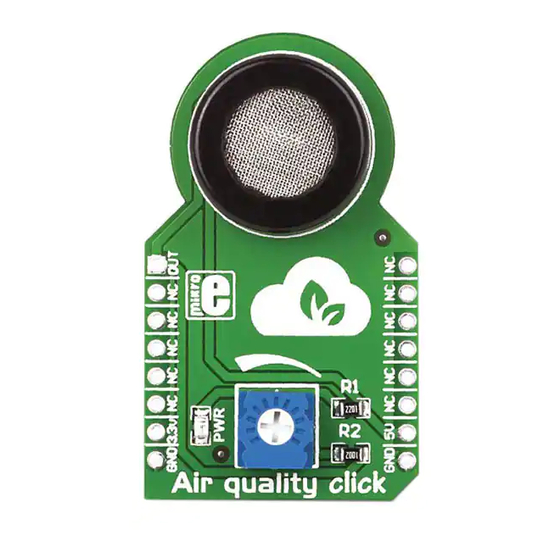
Advertisement
Quick Links
Air quality
click
1. Introduction
Air quality click
is a simple solution
™
for adding a high sensitivity sensor for
detecting a variety of gases that impact
air quality in homes and offices. The board
features an MQ-135 sensor, a calibration
potentiometer, a mikroBUS
host socket,
™
two jumpers and a power indicator LED.
Air quality click
communicates with the
™
target board through mikroBUS
AN (OUT)
™
line. Air quality click
is designed to use a
™
5V power supply only.
Arrow.com.
Downloaded from
2. Soldering the headers
Before using your click
board, make sure
™
to solder 1x8 male headers to both left
and right side of the board. Two 1x8 male
headers are included with the board in
the package.
™
2
Turn the board upside down so that
the bottom side is facing you upwards.
Place shorter pins of the header into the
appropriate soldering pads.
1
3
Turn the board upward again. Make sure
to align the headers so that they are
perpendicular to the board, then solder
the pins carefully.
3. Plugging the board in
Once you have soldered the headers your
board is ready to be placed into the desired
mikroBUS
™
socket. Make sure to align the
cut in the lower-right part of the board
with the markings on the silkscreen at the
mikroBUS
socket. If all the pins
™
are aligned correctly, push the
board all the way into the socket.
4. Essential features
Air quality click
is suitable for detecting
™
ammonia (NH
), nitrogen oxides (NOx)
3
benzene, smoke, CO
and other harmful or
2
poisonous gases that impact air quality. The
MQ-135 sensor unit has a sensor layer made
of tin dioxide (SnO
), an inorganic compound
2
which has lower conductivity in clean air
than when polluting gases are present. Air
quality click
™
also contains a potentiometer
that lets you adjust the sensor for the
environment you'll be using it in.
click
™
BOARD
www.mikroe.com
Air quality click Manual
ver. 1.00
0 100000 026588
Advertisement

Subscribe to Our Youtube Channel
Summary of Contents for mikroElektronika Air quality click MIKROE-1630
- Page 1 2. Soldering the headers Before using your click board, make sure ™ to solder 1x8 male headers to both left and right side of the board. Two 1x8 male headers are included with the board in the package. Air quality click ™...
- Page 2 MikroElektronika assumes no responsibility or liability for any errors or inaccuracies that may appear in the present document. Specification and information contained in the present schematic are subject to change at any time without notice. Copyright © 2014 MikroElektronika. All rights reserved.
















Need help?
Do you have a question about the Air quality click MIKROE-1630 and is the answer not in the manual?
Questions and answers